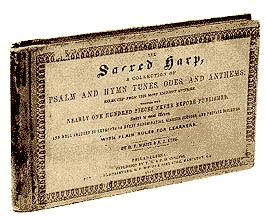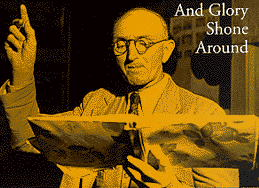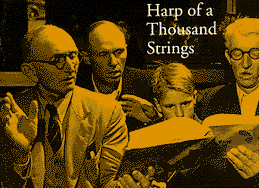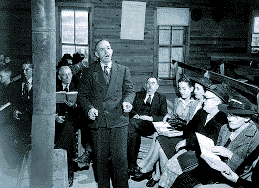
Michael Stone listens to the other side of the gospel
on new recordings from The Library of Congress and The Alan Lomax Collection
Present Joys (excerpt) |

Embracing those influences, New England hymnody reemerged in the late 1700s as itinerant singing-school masters helped spread an American religious revival promoting the individual's direct personal relationship with the divine, free of intervening Church authority. Using the shape-note system invented to simplify sight reading for the musically untutored masses, Sacred Harp promoted a participatory democratic ideology of individualistic faith and deliverance, setting devotional lyrics derived from psalms and other sacred sources to the familiar melodies of British and North American folk songs.
Singing schools spread from New England through the Appalachians, moving westward across the Blue Ridge and the Mississippi, reaching Missouri by the 1820s. But southern rural Protestant denominations would embrace Sacred Harp most devoutly. Its collective production entailed a brilliant, ragged choral heterophony, eschewing classical harmonic refinement for the dramatic abandon of an unadorned mass articulation of personal and immediate religious experience. Hence the untrained voices of these recordings frequently break and quaver in moving personal testimonies, fervent eulogies to the dead, stirring hymns and heartfelt prayers.

Yet Sacred Harp today expresses far more than the aesthetic nostalgia rendered to a quaint spiritual tradition in effective decline. It still enunciates a pervasive civic faith, the consecrated ideology of American individualism, proclaiming a resolute calculus of personal responsibility, eternal retribution, divine revelation and ecstatic deliverance. In the fundamentalist tenor of these millennial times, a sober prophetic choir intones the stoic certitude of a rugged, solitary nation before its anointed global mission, trampling out the wrathful vintage of almighty judgment and redemption, everywhere separating - with terrible swift sword - the chosen from the damned. Now listen to these recordings.

Alabama Sacred Harp Singers: Sacred Harp Singing
The Alan Lomax Collection: Southern Journey
Volume 9: Harp of a Thousand Strings: All Day Singing from the Sacred Harp
Volume 10: And Glory Shone Around: More All Day Singing from the Sacred Harp
All three recordings have been reissued by Rounder Records (www.rounder.com)
see also:
The Lomax Collection
The Library of Congress Archive of Folk Culture
Sound sample: "Present Joys," from And Glory Shone Around
25 second excerpt. Public Domain